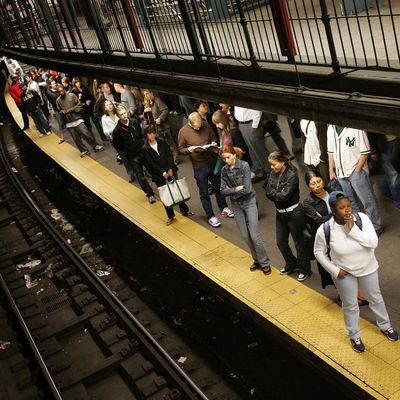
And there shall be much rejoicing: This week, the MTA announced that it will be piloting some rather spiffy LCD countdown clocks in eight N, Q, or R stations, with the plans, as per DNAInfo, to “eventually” expand to all 269 lettered-line stations across New York. They’ll use Bluetooth to communicate with the trains, to give you, the eager straphanger, real-time info on when the hell that train is finally going to get there.
This is a very good thing, because while waiting sucks as a rule, not having anything to occupy your time and not knowing when the thing you’re waiting on will arrive is especially excruciating. In 1985, the Venezuelan psychologist Edgar Elías Osuna dug deep into the psychological cost of waiting, and after a ton of fancy math, determined that the stress of waiting could be “explained by the sense of waste the individual associates to the time spent in waiting, and by the uncertainty he may have about the time he will still have to wait.” What’s worse, he says, is that stress accumulates the longer you wait, as anyone who’s been marooned by flight delays at LaGuardia can attest. But real-time knowledge of the wait reduces “the psychological stress and anxiety” associated with a given queue.
While Osuna doesn’t mention this, it looks like what’s going on here is what personality psychologists call “need for closure”: Basically, everybody is on a spectrum of how much certainty they need to feel safe, secure, and happy. If you’re high in need for closure, as seemingly all hard-charging, appointment-setting New Yorkers are, being stuck in ambiguous situations makes you want to throw up. While the countdown clock doesn’t decrease the amount of time that you’re waiting, it does fill that need for knowledge, lending your nervous system just a little bit more security.
The easefulness of having a countdown clock as opposed to not having one (looking at you, C train) also has something to do with what queuing researchers call “occupied” versus “unoccupied” time. When you have something to do while you wait, it literally feels shorter than if you didn’t have something to do (which is why an absorbing book or game or conversation makes the wait, like time in general, fly by). That’s why airport designers have taken to moving gates away from baggage claims — customers spend more time walking, less time idling, and thereby, make fewer complaints. Marketing research also finds that when customers’ waiting time is filled, they give better performance reviews; by the same logic, putting mirrors in elevator bays gives shoppers and office workers something to do while waiting for their next ride — scrutinize their appearance. So while looking at the countdown clock isn’t the most engrossing stimulation you’re going to get all day, it does give you something to do.




